Investigating Auditor's Role in Fraud Detection: Data Analysis Report
VerifiedAdded on 2023/05/30
|14
|2066
|198
Report
AI Summary
This report presents a data analysis of the role of auditors in fraud detection within UAE banks, based on a survey of 88 respondents from five different banks. The descriptive statistics cover demographic information such as gender, age, education level, job position, career major, and work exper...

Data analysis, results and discussion
Descriptive statistics
The descriptive statistics give a general structure of the sample dataset used in analysis of the
role of an auditor in fraud detection. It mainly covers the distribution of the variables, that is
frequency, percentages, and averages such as: median, mean, and mode. There are 88
respondents who are involved in the survey working in 5 banks. The banks include:
i. Bank of Sharjah
ii. Sharjah Islamic bank
iii. national bank of Abu Dhabi
iv. bank of Dubai
v. Noor bank
Demographical statistics
Gender
Out of the 88 respondents, 47 are male which represent 53.4% while there are 41 female
respondents who make up 46.6%. We can therefore infer that there are more male and female
respondents.
Age
The age variable is coded from 1 to 6, where:
Age Code
20-30 1
31-35 2
Descriptive statistics
The descriptive statistics give a general structure of the sample dataset used in analysis of the
role of an auditor in fraud detection. It mainly covers the distribution of the variables, that is
frequency, percentages, and averages such as: median, mean, and mode. There are 88
respondents who are involved in the survey working in 5 banks. The banks include:
i. Bank of Sharjah
ii. Sharjah Islamic bank
iii. national bank of Abu Dhabi
iv. bank of Dubai
v. Noor bank
Demographical statistics
Gender
Out of the 88 respondents, 47 are male which represent 53.4% while there are 41 female
respondents who make up 46.6%. We can therefore infer that there are more male and female
respondents.
Age
The age variable is coded from 1 to 6, where:
Age Code
20-30 1
31-35 2
Paraphrase This Document
Need a fresh take? Get an instant paraphrase of this document with our AI Paraphraser
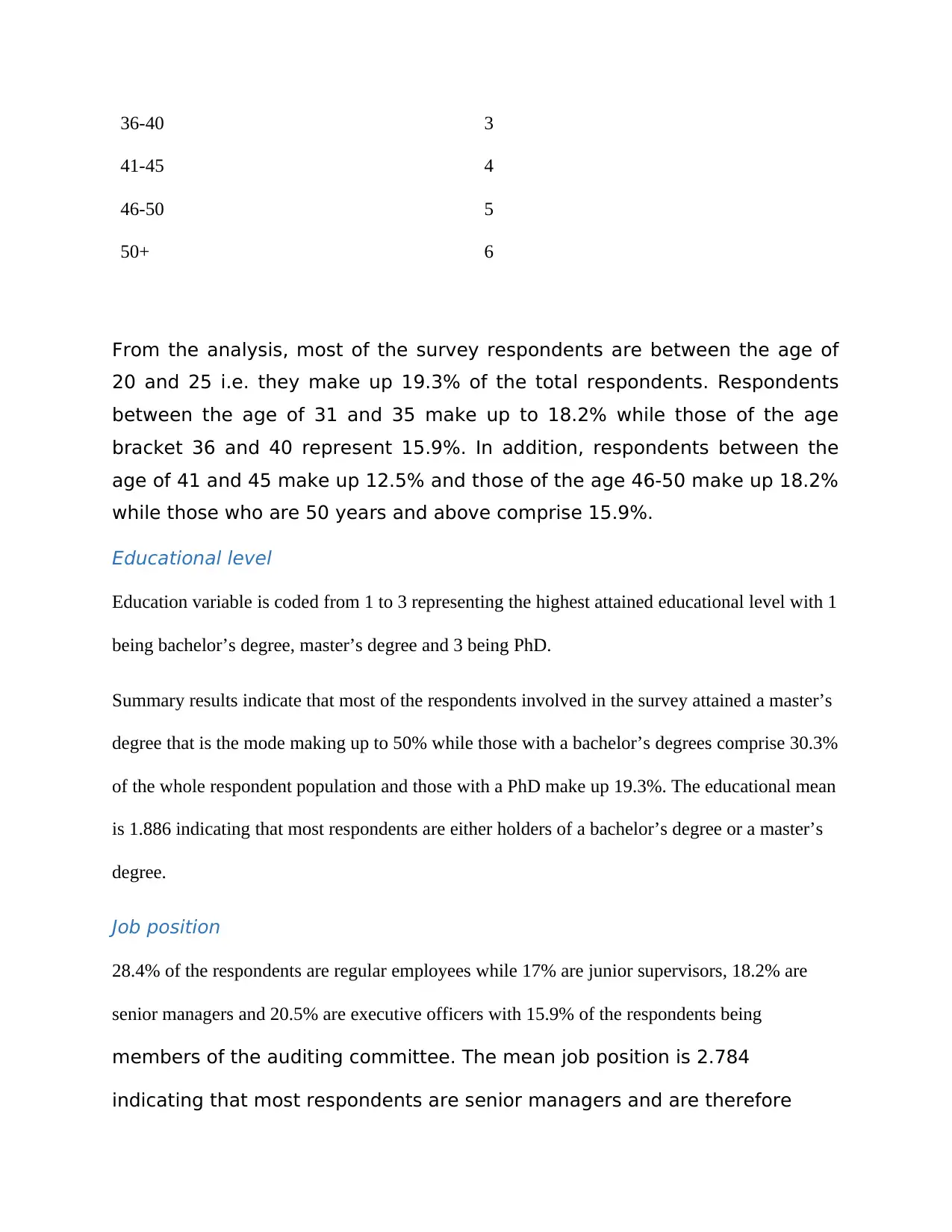
36-40 3
41-45 4
46-50 5
50+ 6
From the analysis, most of the survey respondents are between the age of
20 and 25 i.e. they make up 19.3% of the total respondents. Respondents
between the age of 31 and 35 make up to 18.2% while those of the age
bracket 36 and 40 represent 15.9%. In addition, respondents between the
age of 41 and 45 make up 12.5% and those of the age 46-50 make up 18.2%
while those who are 50 years and above comprise 15.9%.
Educational level
Education variable is coded from 1 to 3 representing the highest attained educational level with 1
being bachelor’s degree, master’s degree and 3 being PhD.
Summary results indicate that most of the respondents involved in the survey attained a master’s
degree that is the mode making up to 50% while those with a bachelor’s degrees comprise 30.3%
of the whole respondent population and those with a PhD make up 19.3%. The educational mean
is 1.886 indicating that most respondents are either holders of a bachelor’s degree or a master’s
degree.
Job position
28.4% of the respondents are regular employees while 17% are junior supervisors, 18.2% are
senior managers and 20.5% are executive officers with 15.9% of the respondents being
members of the auditing committee. The mean job position is 2.784
indicating that most respondents are senior managers and are therefore
41-45 4
46-50 5
50+ 6
From the analysis, most of the survey respondents are between the age of
20 and 25 i.e. they make up 19.3% of the total respondents. Respondents
between the age of 31 and 35 make up to 18.2% while those of the age
bracket 36 and 40 represent 15.9%. In addition, respondents between the
age of 41 and 45 make up 12.5% and those of the age 46-50 make up 18.2%
while those who are 50 years and above comprise 15.9%.
Educational level
Education variable is coded from 1 to 3 representing the highest attained educational level with 1
being bachelor’s degree, master’s degree and 3 being PhD.
Summary results indicate that most of the respondents involved in the survey attained a master’s
degree that is the mode making up to 50% while those with a bachelor’s degrees comprise 30.3%
of the whole respondent population and those with a PhD make up 19.3%. The educational mean
is 1.886 indicating that most respondents are either holders of a bachelor’s degree or a master’s
degree.
Job position
28.4% of the respondents are regular employees while 17% are junior supervisors, 18.2% are
senior managers and 20.5% are executive officers with 15.9% of the respondents being
members of the auditing committee. The mean job position is 2.784
indicating that most respondents are senior managers and are therefore
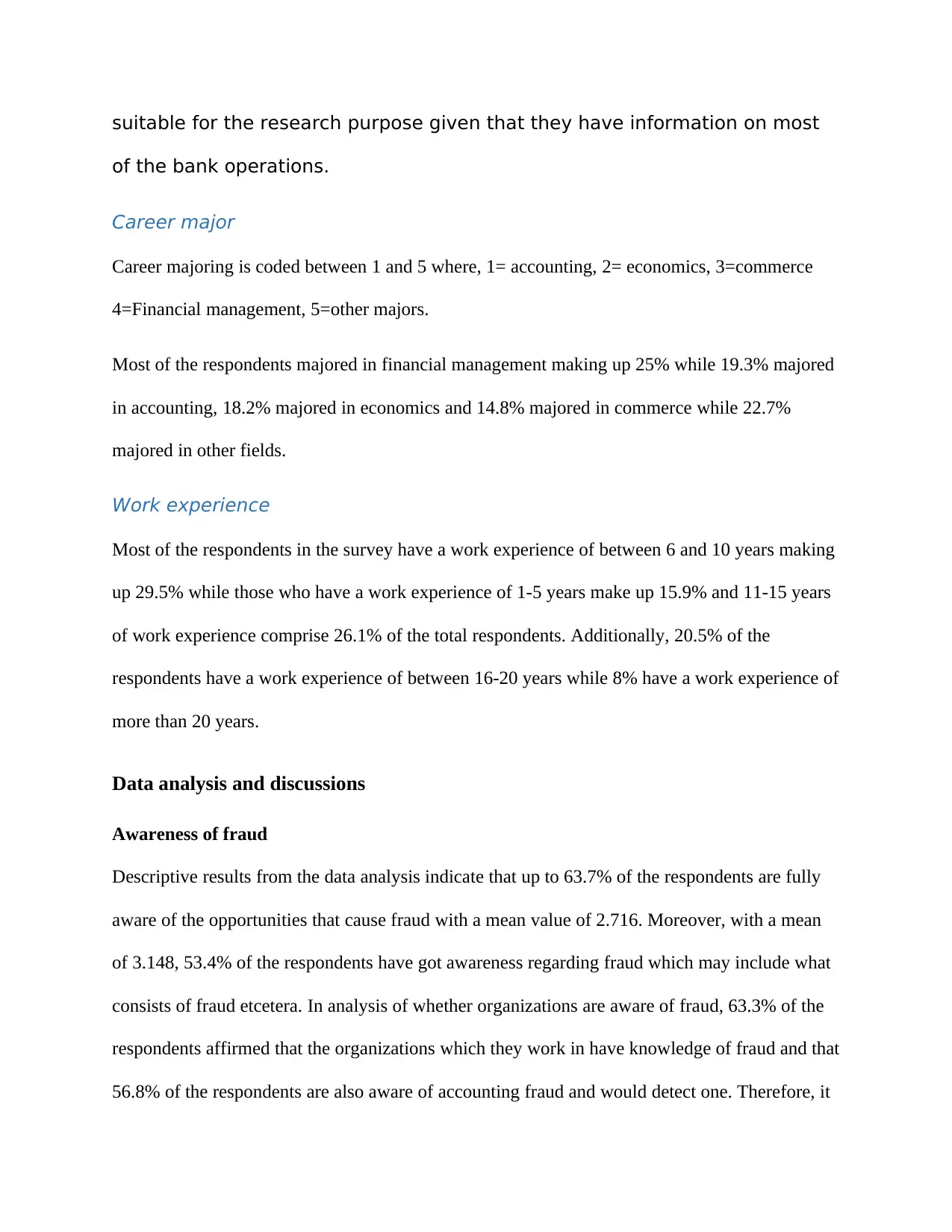
suitable for the research purpose given that they have information on most
of the bank operations.
Career major
Career majoring is coded between 1 and 5 where, 1= accounting, 2= economics, 3=commerce
4=Financial management, 5=other majors.
Most of the respondents majored in financial management making up 25% while 19.3% majored
in accounting, 18.2% majored in economics and 14.8% majored in commerce while 22.7%
majored in other fields.
Work experience
Most of the respondents in the survey have a work experience of between 6 and 10 years making
up 29.5% while those who have a work experience of 1-5 years make up 15.9% and 11-15 years
of work experience comprise 26.1% of the total respondents. Additionally, 20.5% of the
respondents have a work experience of between 16-20 years while 8% have a work experience of
more than 20 years.
Data analysis and discussions
Awareness of fraud
Descriptive results from the data analysis indicate that up to 63.7% of the respondents are fully
aware of the opportunities that cause fraud with a mean value of 2.716. Moreover, with a mean
of 3.148, 53.4% of the respondents have got awareness regarding fraud which may include what
consists of fraud etcetera. In analysis of whether organizations are aware of fraud, 63.3% of the
respondents affirmed that the organizations which they work in have knowledge of fraud and that
56.8% of the respondents are also aware of accounting fraud and would detect one. Therefore, it
of the bank operations.
Career major
Career majoring is coded between 1 and 5 where, 1= accounting, 2= economics, 3=commerce
4=Financial management, 5=other majors.
Most of the respondents majored in financial management making up 25% while 19.3% majored
in accounting, 18.2% majored in economics and 14.8% majored in commerce while 22.7%
majored in other fields.
Work experience
Most of the respondents in the survey have a work experience of between 6 and 10 years making
up 29.5% while those who have a work experience of 1-5 years make up 15.9% and 11-15 years
of work experience comprise 26.1% of the total respondents. Additionally, 20.5% of the
respondents have a work experience of between 16-20 years while 8% have a work experience of
more than 20 years.
Data analysis and discussions
Awareness of fraud
Descriptive results from the data analysis indicate that up to 63.7% of the respondents are fully
aware of the opportunities that cause fraud with a mean value of 2.716. Moreover, with a mean
of 3.148, 53.4% of the respondents have got awareness regarding fraud which may include what
consists of fraud etcetera. In analysis of whether organizations are aware of fraud, 63.3% of the
respondents affirmed that the organizations which they work in have knowledge of fraud and that
56.8% of the respondents are also aware of accounting fraud and would detect one. Therefore, it
⊘ This is a preview!⊘
Do you want full access?
Subscribe today to unlock all pages.

Trusted by 1+ million students worldwide
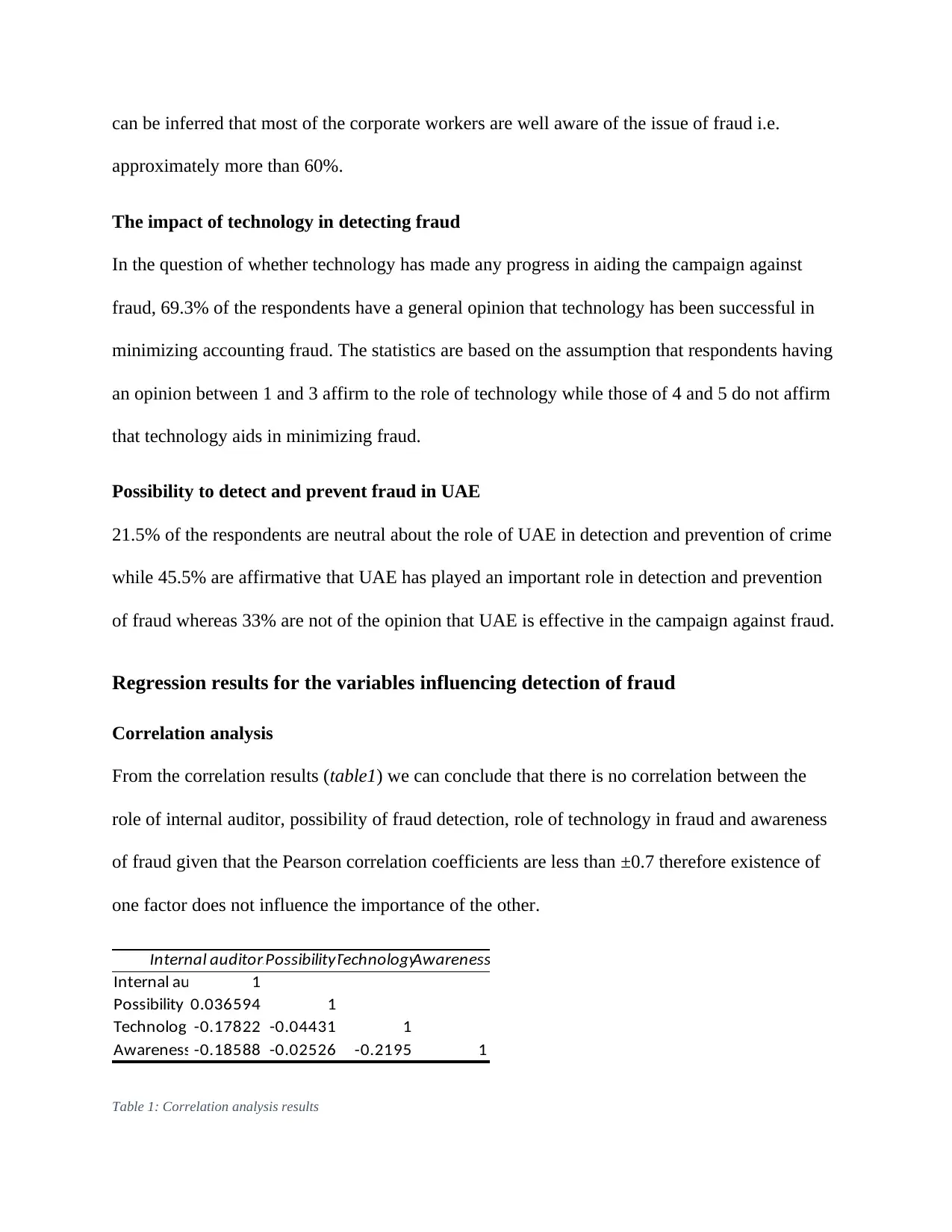
can be inferred that most of the corporate workers are well aware of the issue of fraud i.e.
approximately more than 60%.
The impact of technology in detecting fraud
In the question of whether technology has made any progress in aiding the campaign against
fraud, 69.3% of the respondents have a general opinion that technology has been successful in
minimizing accounting fraud. The statistics are based on the assumption that respondents having
an opinion between 1 and 3 affirm to the role of technology while those of 4 and 5 do not affirm
that technology aids in minimizing fraud.
Possibility to detect and prevent fraud in UAE
21.5% of the respondents are neutral about the role of UAE in detection and prevention of crime
while 45.5% are affirmative that UAE has played an important role in detection and prevention
of fraud whereas 33% are not of the opinion that UAE is effective in the campaign against fraud.
Regression results for the variables influencing detection of fraud
Correlation analysis
From the correlation results (table1) we can conclude that there is no correlation between the
role of internal auditor, possibility of fraud detection, role of technology in fraud and awareness
of fraud given that the Pearson correlation coefficients are less than ±0.7 therefore existence of
one factor does not influence the importance of the other.
Internal auditors rolePossibilityTechnologyAwareness
Internal au 1
Possibility 0.036594 1
Technolog -0.17822 -0.04431 1
Awareness -0.18588 -0.02526 -0.2195 1
Table 1: Correlation analysis results
approximately more than 60%.
The impact of technology in detecting fraud
In the question of whether technology has made any progress in aiding the campaign against
fraud, 69.3% of the respondents have a general opinion that technology has been successful in
minimizing accounting fraud. The statistics are based on the assumption that respondents having
an opinion between 1 and 3 affirm to the role of technology while those of 4 and 5 do not affirm
that technology aids in minimizing fraud.
Possibility to detect and prevent fraud in UAE
21.5% of the respondents are neutral about the role of UAE in detection and prevention of crime
while 45.5% are affirmative that UAE has played an important role in detection and prevention
of fraud whereas 33% are not of the opinion that UAE is effective in the campaign against fraud.
Regression results for the variables influencing detection of fraud
Correlation analysis
From the correlation results (table1) we can conclude that there is no correlation between the
role of internal auditor, possibility of fraud detection, role of technology in fraud and awareness
of fraud given that the Pearson correlation coefficients are less than ±0.7 therefore existence of
one factor does not influence the importance of the other.
Internal auditors rolePossibilityTechnologyAwareness
Internal au 1
Possibility 0.036594 1
Technolog -0.17822 -0.04431 1
Awareness -0.18588 -0.02526 -0.2195 1
Table 1: Correlation analysis results
Paraphrase This Document
Need a fresh take? Get an instant paraphrase of this document with our AI Paraphraser
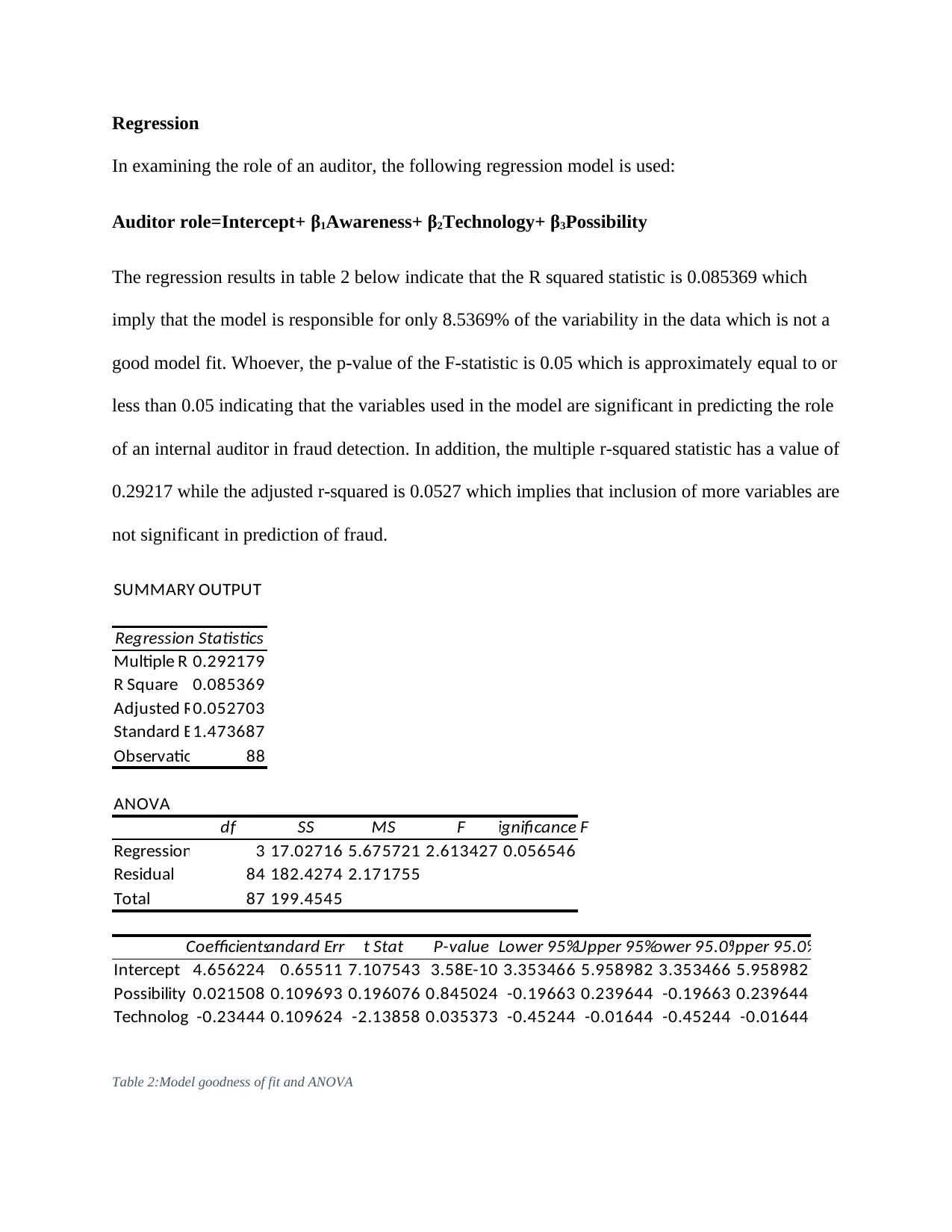
Regression
In examining the role of an auditor, the following regression model is used:
Auditor role=Intercept+ β1Awareness+ β2Technology+ β3Possibility
The regression results in table 2 below indicate that the R squared statistic is 0.085369 which
imply that the model is responsible for only 8.5369% of the variability in the data which is not a
good model fit. Whoever, the p-value of the F-statistic is 0.05 which is approximately equal to or
less than 0.05 indicating that the variables used in the model are significant in predicting the role
of an internal auditor in fraud detection. In addition, the multiple r-squared statistic has a value of
0.29217 while the adjusted r-squared is 0.0527 which implies that inclusion of more variables are
not significant in prediction of fraud.
SUMMARY OUTPUT
Regression Statistics
Multiple R 0.292179
R Square 0.085369
Adjusted R0.052703
Standard E1.473687
Observatio 88
ANOVA
df SS MS F Significance F
Regression 3 17.02716 5.675721 2.613427 0.056546
Residual 84 182.4274 2.171755
Total 87 199.4545
CoefficientsStandard Error t Stat P-value Lower 95%Upper 95%Lower 95.0%Upper 95.0%
Intercept 4.656224 0.65511 7.107543 3.58E-10 3.353466 5.958982 3.353466 5.958982
Possibility 0.021508 0.109693 0.196076 0.845024 -0.19663 0.239644 -0.19663 0.239644
Technolog -0.23444 0.109624 -2.13858 0.035373 -0.45244 -0.01644 -0.45244 -0.01644
Table 2:Model goodness of fit and ANOVA
In examining the role of an auditor, the following regression model is used:
Auditor role=Intercept+ β1Awareness+ β2Technology+ β3Possibility
The regression results in table 2 below indicate that the R squared statistic is 0.085369 which
imply that the model is responsible for only 8.5369% of the variability in the data which is not a
good model fit. Whoever, the p-value of the F-statistic is 0.05 which is approximately equal to or
less than 0.05 indicating that the variables used in the model are significant in predicting the role
of an internal auditor in fraud detection. In addition, the multiple r-squared statistic has a value of
0.29217 while the adjusted r-squared is 0.0527 which implies that inclusion of more variables are
not significant in prediction of fraud.
SUMMARY OUTPUT
Regression Statistics
Multiple R 0.292179
R Square 0.085369
Adjusted R0.052703
Standard E1.473687
Observatio 88
ANOVA
df SS MS F Significance F
Regression 3 17.02716 5.675721 2.613427 0.056546
Residual 84 182.4274 2.171755
Total 87 199.4545
CoefficientsStandard Error t Stat P-value Lower 95%Upper 95%Lower 95.0%Upper 95.0%
Intercept 4.656224 0.65511 7.107543 3.58E-10 3.353466 5.958982 3.353466 5.958982
Possibility 0.021508 0.109693 0.196076 0.845024 -0.19663 0.239644 -0.19663 0.239644
Technolog -0.23444 0.109624 -2.13858 0.035373 -0.45244 -0.01644 -0.45244 -0.01644
Table 2:Model goodness of fit and ANOVA
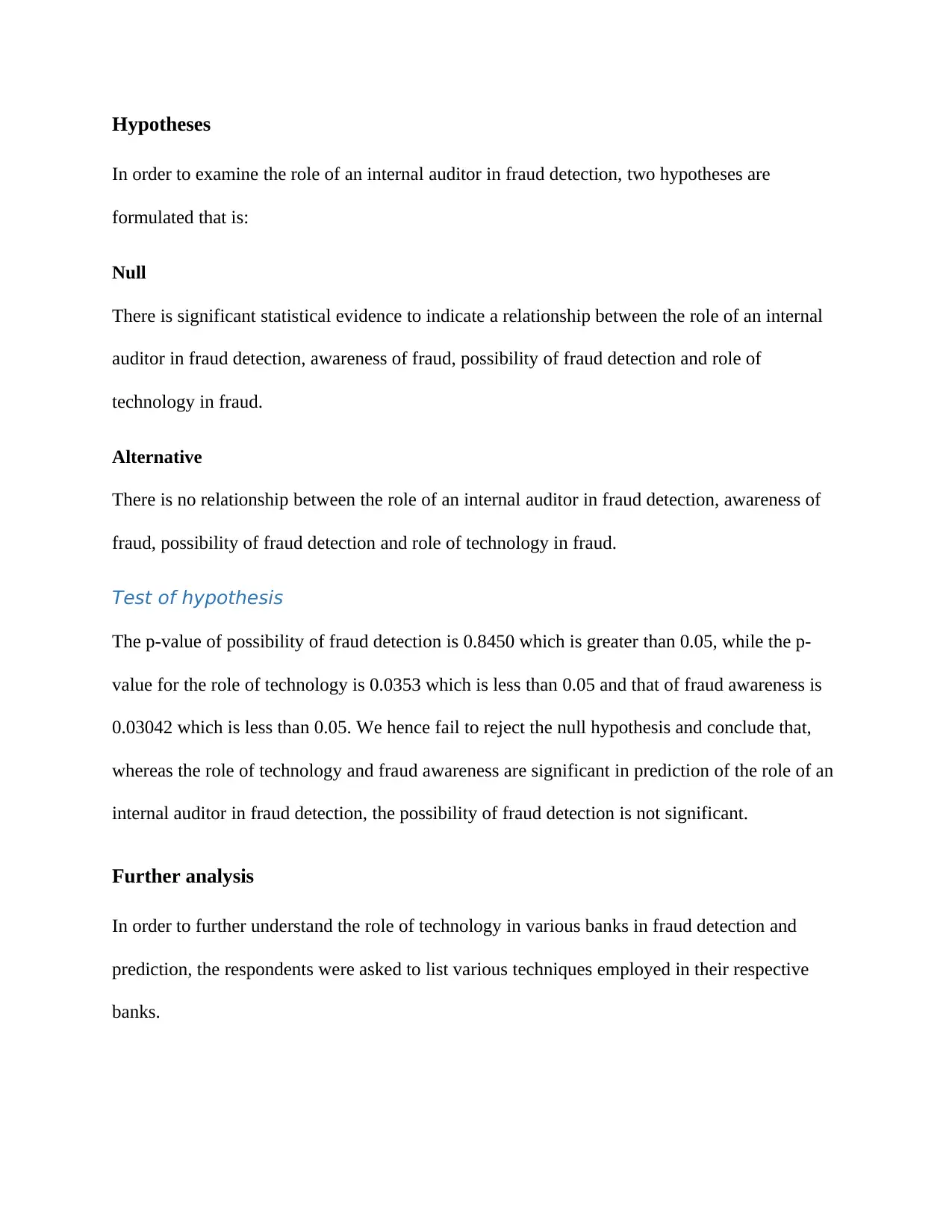
Hypotheses
In order to examine the role of an internal auditor in fraud detection, two hypotheses are
formulated that is:
Null
There is significant statistical evidence to indicate a relationship between the role of an internal
auditor in fraud detection, awareness of fraud, possibility of fraud detection and role of
technology in fraud.
Alternative
There is no relationship between the role of an internal auditor in fraud detection, awareness of
fraud, possibility of fraud detection and role of technology in fraud.
Test of hypothesis
The p-value of possibility of fraud detection is 0.8450 which is greater than 0.05, while the p-
value for the role of technology is 0.0353 which is less than 0.05 and that of fraud awareness is
0.03042 which is less than 0.05. We hence fail to reject the null hypothesis and conclude that,
whereas the role of technology and fraud awareness are significant in prediction of the role of an
internal auditor in fraud detection, the possibility of fraud detection is not significant.
Further analysis
In order to further understand the role of technology in various banks in fraud detection and
prediction, the respondents were asked to list various techniques employed in their respective
banks.
In order to examine the role of an internal auditor in fraud detection, two hypotheses are
formulated that is:
Null
There is significant statistical evidence to indicate a relationship between the role of an internal
auditor in fraud detection, awareness of fraud, possibility of fraud detection and role of
technology in fraud.
Alternative
There is no relationship between the role of an internal auditor in fraud detection, awareness of
fraud, possibility of fraud detection and role of technology in fraud.
Test of hypothesis
The p-value of possibility of fraud detection is 0.8450 which is greater than 0.05, while the p-
value for the role of technology is 0.0353 which is less than 0.05 and that of fraud awareness is
0.03042 which is less than 0.05. We hence fail to reject the null hypothesis and conclude that,
whereas the role of technology and fraud awareness are significant in prediction of the role of an
internal auditor in fraud detection, the possibility of fraud detection is not significant.
Further analysis
In order to further understand the role of technology in various banks in fraud detection and
prediction, the respondents were asked to list various techniques employed in their respective
banks.
⊘ This is a preview!⊘
Do you want full access?
Subscribe today to unlock all pages.

Trusted by 1+ million students worldwide

Method employed Number Percentage
Tip off 19 29%
Bank reconciliation 37 76%
segregation of duties 56 82%
internal audit routine 20 42%
data mining 39 81%
digital analytics 27 40%
red flags 12 21%
whistle-blowing system 66 81%
suspicious transactions
reporting 53 89%
firewall 30 51%
validation, error correction 47 74%
other 32 61%
Total of respondents 88 100%
Figure 1: Method used by auditors and organizations
From figure 1, the most used method in fraud detection is bank reconciliation (76%), data mining
(81%), segregation of duties (82%), whistle blowing (81%) and reporting of suspicious
transactions (89%), validation, error correction (74%).
Risk assessment routine taken by the focus banks
In accessing how frequent the banks conduct a risk assessment routine, that is to detect cases of
fraud, questions regarding the awareness of employees in the conduction of fraud detection
exercise were asked. From the responses, 12% are not aware of their how
frequent risk assessment is conducted by their banks while the remaining
88% are aware (figure 2). Of the 88% who are aware, 48% noted that the
assessment was conducted quarterly, 19% was annually while 25% semi-
annually and 8% were not sure of the frequency (figure 3).
Tip off 19 29%
Bank reconciliation 37 76%
segregation of duties 56 82%
internal audit routine 20 42%
data mining 39 81%
digital analytics 27 40%
red flags 12 21%
whistle-blowing system 66 81%
suspicious transactions
reporting 53 89%
firewall 30 51%
validation, error correction 47 74%
other 32 61%
Total of respondents 88 100%
Figure 1: Method used by auditors and organizations
From figure 1, the most used method in fraud detection is bank reconciliation (76%), data mining
(81%), segregation of duties (82%), whistle blowing (81%) and reporting of suspicious
transactions (89%), validation, error correction (74%).
Risk assessment routine taken by the focus banks
In accessing how frequent the banks conduct a risk assessment routine, that is to detect cases of
fraud, questions regarding the awareness of employees in the conduction of fraud detection
exercise were asked. From the responses, 12% are not aware of their how
frequent risk assessment is conducted by their banks while the remaining
88% are aware (figure 2). Of the 88% who are aware, 48% noted that the
assessment was conducted quarterly, 19% was annually while 25% semi-
annually and 8% were not sure of the frequency (figure 3).
Paraphrase This Document
Need a fresh take? Get an instant paraphrase of this document with our AI Paraphraser
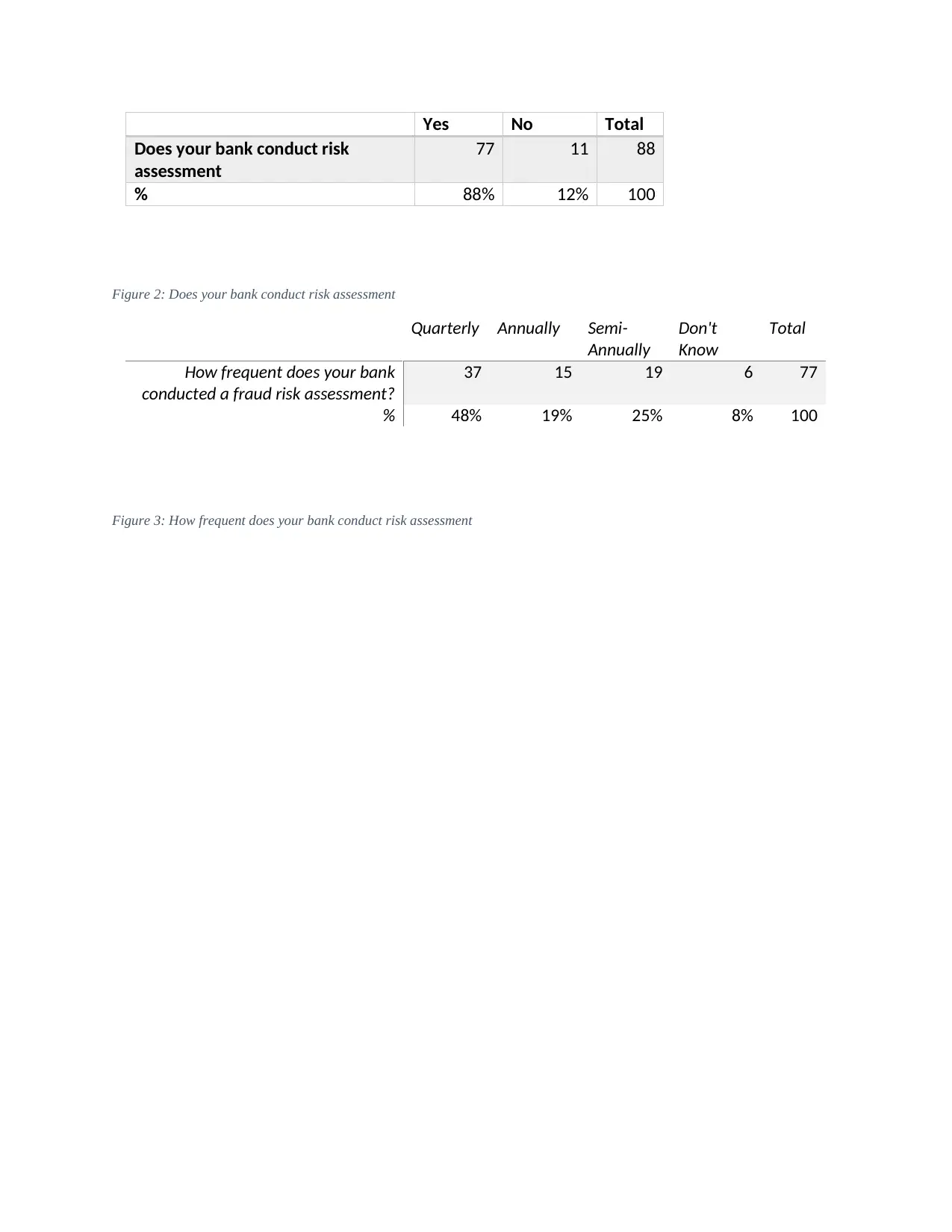
Yes No Total
Does your bank conduct risk
assessment
77 11 88
% 88% 12% 100
Figure 2: Does your bank conduct risk assessment
Quarterly Annually Semi-
Annually
Don't
Know
Total
How frequent does your bank
conducted a fraud risk assessment?
37 15 19 6 77
% 48% 19% 25% 8% 100
Figure 3: How frequent does your bank conduct risk assessment
Does your bank conduct risk
assessment
77 11 88
% 88% 12% 100
Figure 2: Does your bank conduct risk assessment
Quarterly Annually Semi-
Annually
Don't
Know
Total
How frequent does your bank
conducted a fraud risk assessment?
37 15 19 6 77
% 48% 19% 25% 8% 100
Figure 3: How frequent does your bank conduct risk assessment
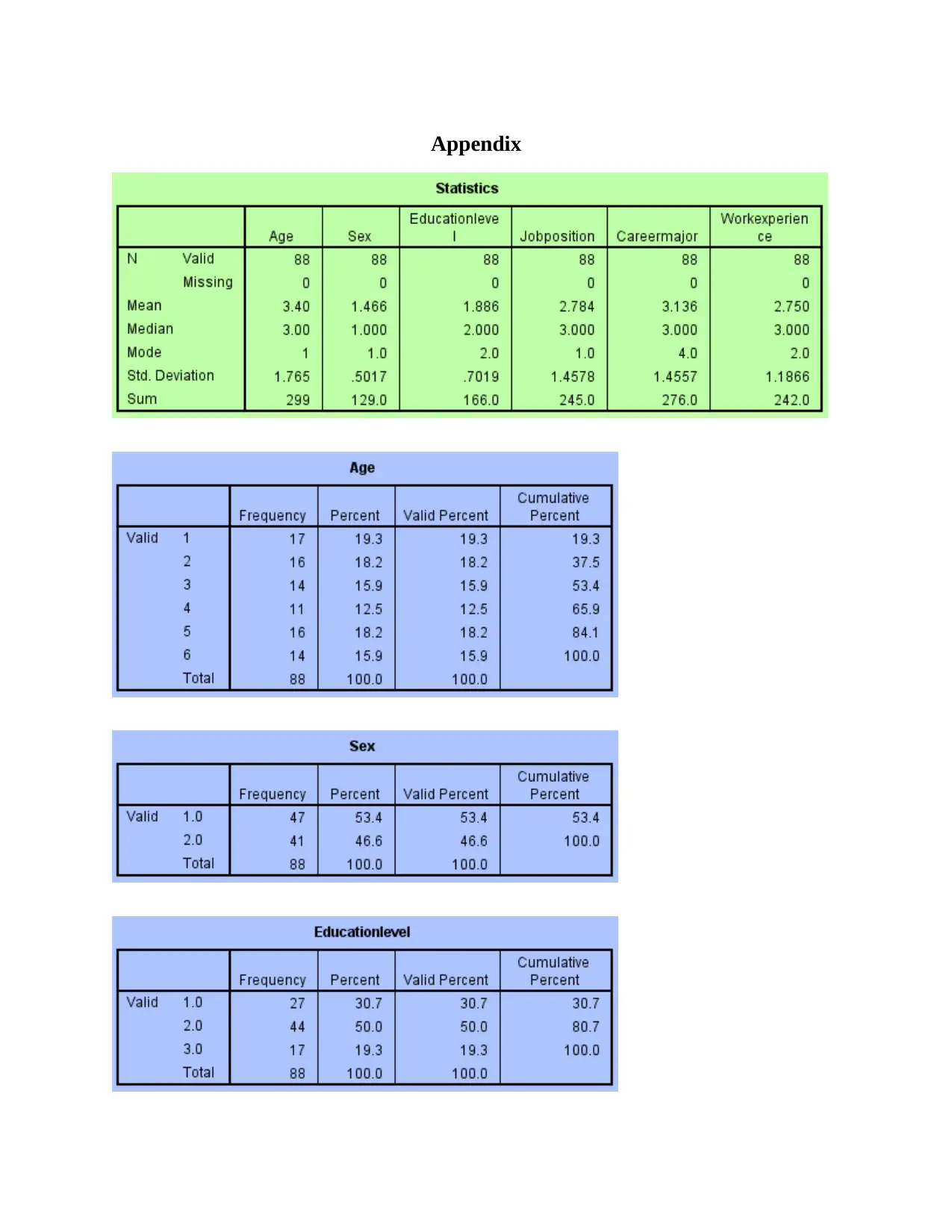
Appendix
⊘ This is a preview!⊘
Do you want full access?
Subscribe today to unlock all pages.

Trusted by 1+ million students worldwide
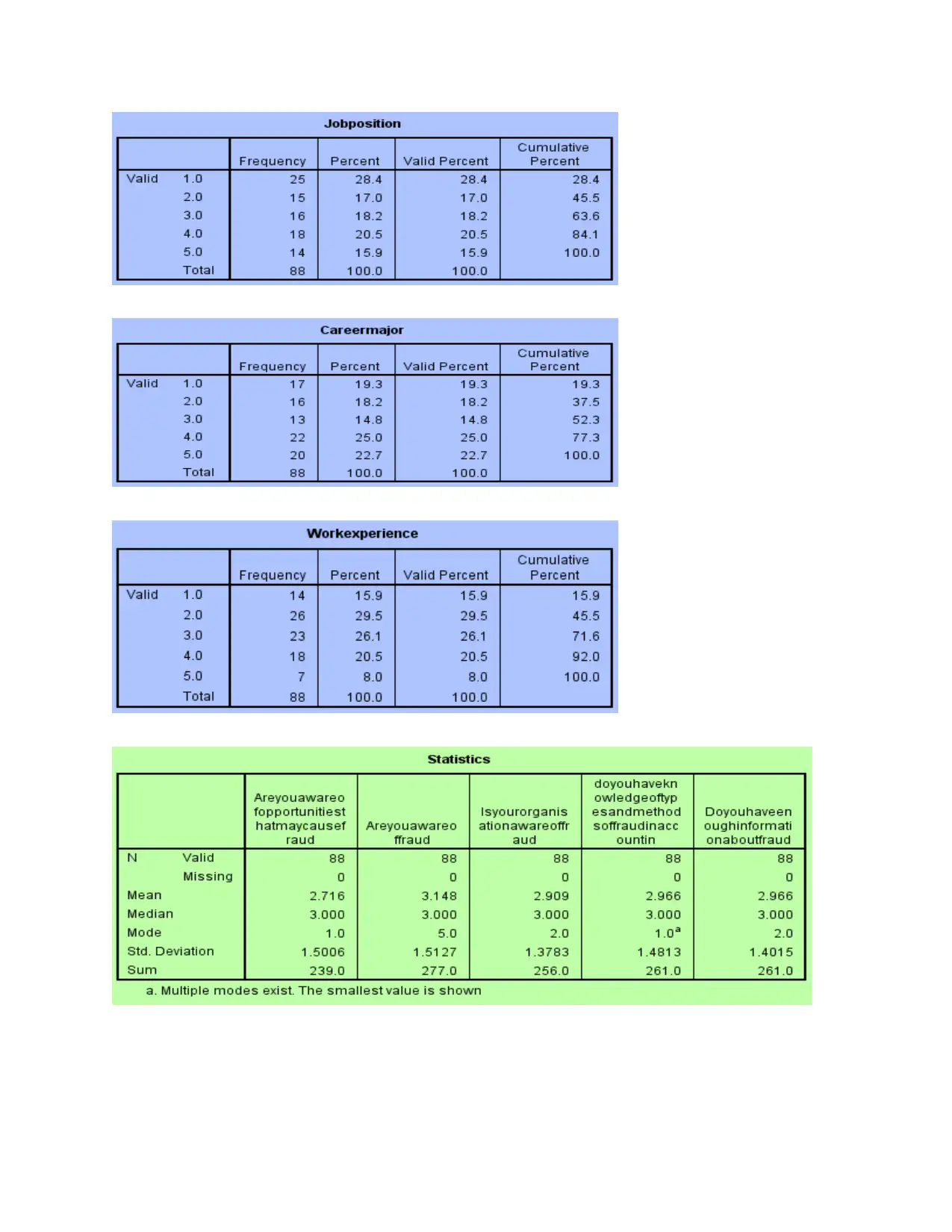
Paraphrase This Document
Need a fresh take? Get an instant paraphrase of this document with our AI Paraphraser
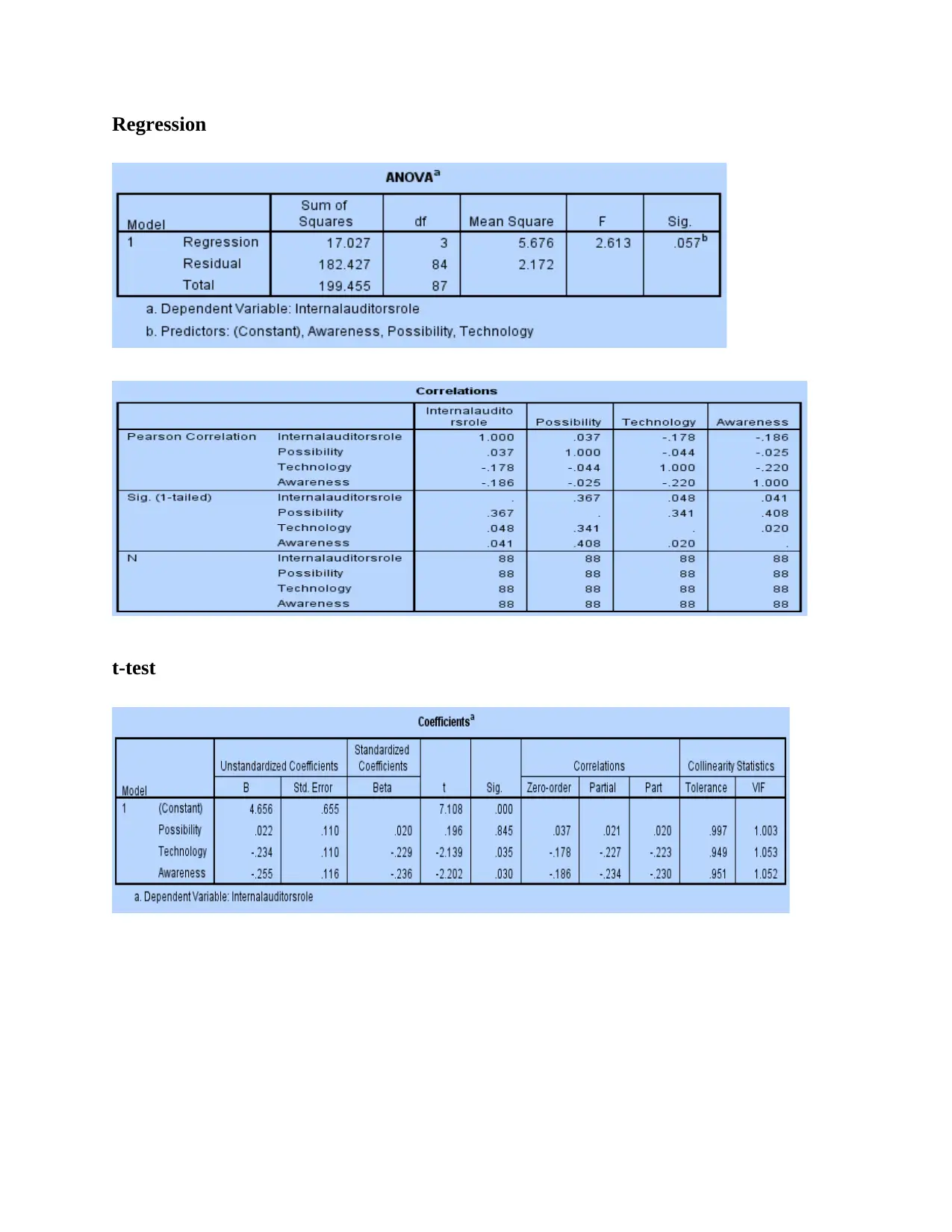
Regression
t-test
t-test
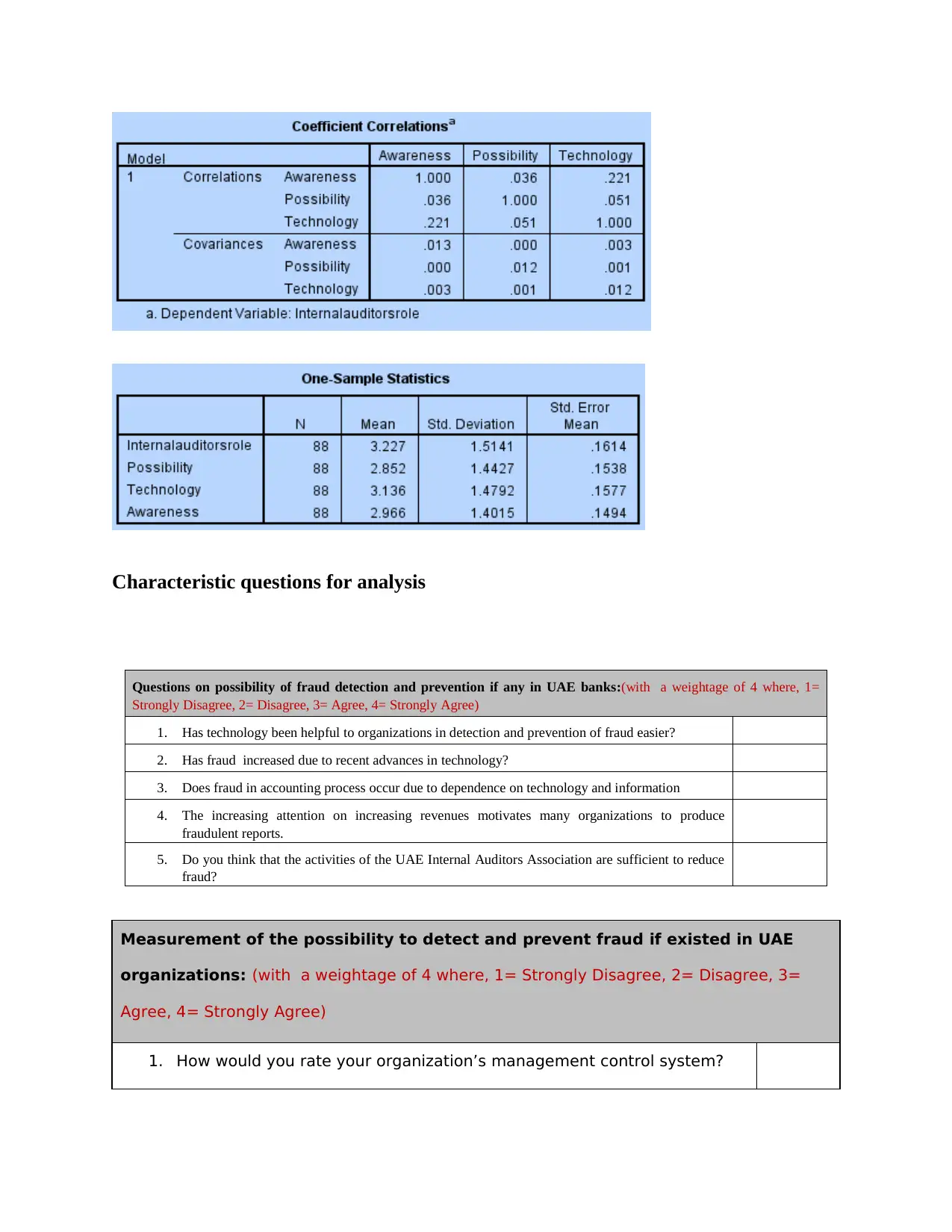
Characteristic questions for analysis
Questions on possibility of fraud detection and prevention if any in UAE banks:(with a weightage of 4 where, 1=
Strongly Disagree, 2= Disagree, 3= Agree, 4= Strongly Agree)
1. Has technology been helpful to organizations in detection and prevention of fraud easier?
2. Has fraud increased due to recent advances in technology?
3. Does fraud in accounting process occur due to dependence on technology and information
4. The increasing attention on increasing revenues motivates many organizations to produce
fraudulent reports.
5. Do you think that the activities of the UAE Internal Auditors Association are sufficient to reduce
fraud?
Measurement of the possibility to detect and prevent fraud if existed in UAE
organizations: (with a weightage of 4 where, 1= Strongly Disagree, 2= Disagree, 3=
Agree, 4= Strongly Agree)
1. How would you rate your organization’s management control system?
Questions on possibility of fraud detection and prevention if any in UAE banks:(with a weightage of 4 where, 1=
Strongly Disagree, 2= Disagree, 3= Agree, 4= Strongly Agree)
1. Has technology been helpful to organizations in detection and prevention of fraud easier?
2. Has fraud increased due to recent advances in technology?
3. Does fraud in accounting process occur due to dependence on technology and information
4. The increasing attention on increasing revenues motivates many organizations to produce
fraudulent reports.
5. Do you think that the activities of the UAE Internal Auditors Association are sufficient to reduce
fraud?
Measurement of the possibility to detect and prevent fraud if existed in UAE
organizations: (with a weightage of 4 where, 1= Strongly Disagree, 2= Disagree, 3=
Agree, 4= Strongly Agree)
1. How would you rate your organization’s management control system?
⊘ This is a preview!⊘
Do you want full access?
Subscribe today to unlock all pages.

Trusted by 1+ million students worldwide

2. How would you rate your organization’s ability to detect and prevent
fraud?
3. How frequent does your organization consider audit process in the
financial statements?
4. How successful technology is minimizing accounting fraud?
5. How good are the steps in accounting fraud recognition with the
technology regard?
Investigation on awareness of FRAUD in the UAE Banks:
(with a weightage of 4 where, 1= Strongly Disagree, 2= Disagree, 3= Agree, 4= Strongly
Agree)
1. Do you have adequate information about fraud.
2. Is fraud is regarded as a major concern to business activities in UAE?
3. What fraud awareness level does your bank have?
4. Do you know of opportunities that may allow fraud, for instance
weaknesses in regulatory systems?
5. Do you have the information on types and methods of fraud in
accounting?
fraud?
3. How frequent does your organization consider audit process in the
financial statements?
4. How successful technology is minimizing accounting fraud?
5. How good are the steps in accounting fraud recognition with the
technology regard?
Investigation on awareness of FRAUD in the UAE Banks:
(with a weightage of 4 where, 1= Strongly Disagree, 2= Disagree, 3= Agree, 4= Strongly
Agree)
1. Do you have adequate information about fraud.
2. Is fraud is regarded as a major concern to business activities in UAE?
3. What fraud awareness level does your bank have?
4. Do you know of opportunities that may allow fraud, for instance
weaknesses in regulatory systems?
5. Do you have the information on types and methods of fraud in
accounting?
Paraphrase This Document
Need a fresh take? Get an instant paraphrase of this document with our AI Paraphraser

1 out of 14
Your All-in-One AI-Powered Toolkit for Academic Success.
+13062052269
info@desklib.com
Available 24*7 on WhatsApp / Email
![[object Object]](/_next/static/media/star-bottom.7253800d.svg)
Unlock your academic potential
© 2024 | Zucol Services PVT LTD | All rights reserved.

